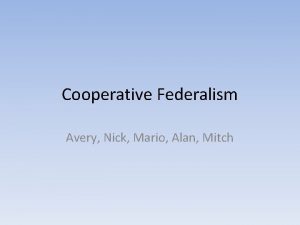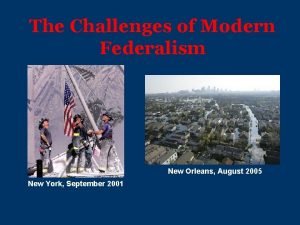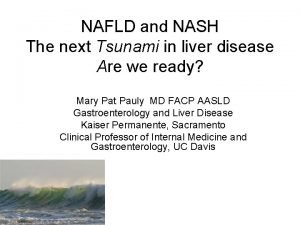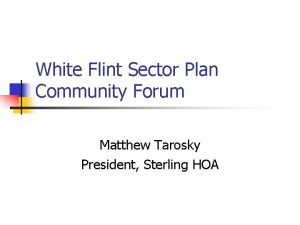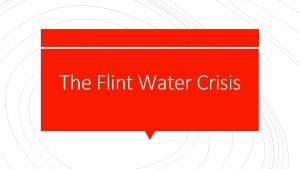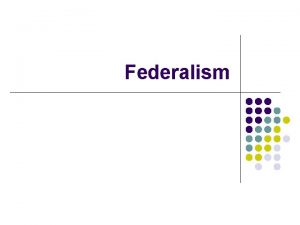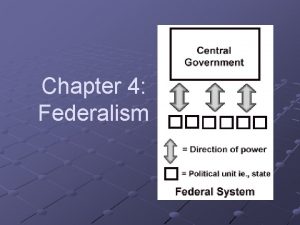The Failure of Cooperative Federalism in Flint Michigan






![EPA Emergency Powers – CWA and SDWA CWA – Section 1364 [T]he Administrator upon EPA Emergency Powers – CWA and SDWA CWA – Section 1364 [T]he Administrator upon](https://slidetodoc.com/presentation_image/ab4c2d40e2e2b71bb7681a81032e53fd/image-7.jpg)



- Slides: 10

The Failure of Cooperative Federalism in Flint Michigan: Implications for EPA Oversight NACWA Hot Topic Series Brent Fewell March 16, 2016 www. earthandwatergroup. com

Unprecedented press coverage – hundreds of domestic and international TV and print coverage

Key Facts Population 99, 000 40% of residents below the poverty level – MHI is $26, 339 v. $53, 657 national Switched water source in 2014 to save $5 M yearly Est. 6, 000 – 12, 000 children exposed to dangerous levels of Pb Long-term health care costs could exceed $100 M Highest water rates in the country $75. 84/month or 3. 5% of MHI.

Timeline April 2104 Flint switches water source Feb 2015 EPA R 5 staff raise concern to MDEQ (one home -104 ppb) June 2015 EPA R 5 Del Toral memo calls lack of corrosion control “major concern”(shared with MDEQ via third party) Aug 2015 Virginia Tech’s Marc Edwards begins independent testing Sep 2015 Flint issues lead warning Nov 2015 EPA Memo finalized/shared with MDEQ Jan 2016 Gov. Snyder declares state of emergency and EPA HQs issues emergency order


EPA-MDEQ Communication After MDEQ was provided a copy of Miguel Del Toral’s June 24 memo on high lead levels in Flint by a third party, MDEQ was notified by an EPA R 5 staff in an e-mail: I wanted to remind you that Miguel’s report had DEQ cc’d. So if the Legislature or who ever (sic) might say you all were cc’d, you can truthfully respond that it was EPA’s request that the report not be sent to the cc’s. Consequently, you all never received the report from Miguel.
![EPA Emergency Powers CWA and SDWA CWA Section 1364 The Administrator upon EPA Emergency Powers – CWA and SDWA CWA – Section 1364 [T]he Administrator upon](https://slidetodoc.com/presentation_image/ab4c2d40e2e2b71bb7681a81032e53fd/image-7.jpg)
EPA Emergency Powers – CWA and SDWA CWA – Section 1364 [T]he Administrator upon receipt of evidence that a pollution source or combination of sources is presenting an imminent and substantial endangerment to the health of persons or to the welfare of persons where such endangerment is to the livelihood of such persons. . . may bring suit on behalf of the U. S. in the appropriate district court to immediately restrain any person causing or contributing to the alleged pollution to stop the discharge of pollutants causing or contributing to such pollution or to take such other action as may be necessary. SDWA – Section 300 i [T]he Administrator, upon receipt of information that a contaminant which is present in or is likely to enter a public water system or an underground source of drinking water. . . which may present an imminent and substantial endangerment to the health of persons, and that the State and local authorities have not acted to protect the health of such persons, may take such action as he may deem necessary in order to protect the health of such persons. To the extent he determines it to be practicable in light of such imminent endangerment, he shall consult with the State and local authorities in order to confirm the correctness of the information on which action proposed to be taken under this subsection is based and to ascertain the action which such authorities are or will be taking. The action which the Administrator may take may include (1) issuing such orders as my be necessary to protect the health of such persons who are or may be users of such system. . . and (2) commencing a civil action for appropriate relief, including a restraining order or permanent or temporary injunction.

Practical Implications Flint impacted psyche of EPA – sentiment is “never again” Greater EPA scrutiny + less deference = more aggressive oversight. Ø Ø Ø Next Gen Compliance Filling “gray areas” at the intersection of law and public health Direct enforcement and overfiling Emergency orders Future municipal water supply enforcement initiative More problems and $ = affordability concerns heightened EJ water-related issues will drive enforcement decisions (SDWA/CWA) More pressure on local governments and leaders (including possibly criminal actions) Less trust? ? ?

“Take Homes” Effective Utility Management • Product Quality • Employee and Leadership Development • Financial Viability • Operational Resiliency • Water Resource Adequacy • Customer Satisfaction • Operational Optimization • Infrastructure Stability • Community Sustainability • Stakeholder Understanding and Support Must summon courage to fill “Gray Areas” with sound policy and best practices We can only improve utility management with improved “transparency”and trust between regulated and regulators More CARROTS to incent good behavior and bigger STICKS to disincent bad behavior (safe harbors, best practices, compliance audits, financial incentives, flexible compliance schedules)

Thank You www. earthandwatergroup. com
